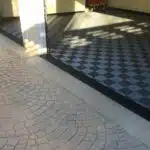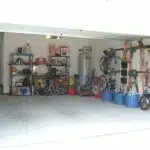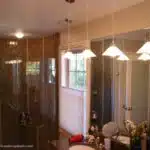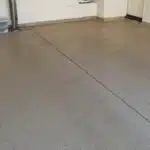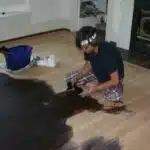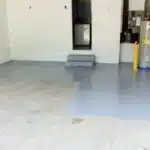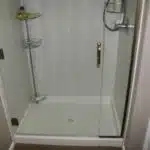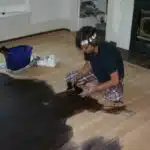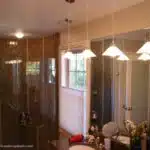The garage is an essential part of any home, serving as a storage space for vehicles, tools, and equipment. However, it’s also a notorious location for dust accumulation, which can be harmful to both your health and the belongings stored within. As a professional home organizer, I understand the importance of maintaining a clean and organized garage space that promotes safety and functionality.
Controlling dust in the garage can be a daunting task, but with proper planning and execution, it’s possible to achieve an environment that’s free from dust buildup. In this article, I will share some practical tips on how to control dust in your garage effectively. From using appropriate cleaning tools to adopting preventative measures, these tips will help you maintain a clean and healthy garage space that serves you well.
Identifying Common Causes Of Dust In The Garage
Preventing and eliminating dust in the garage can be approached in two ways: reducing the sources of dust and blocking its entry. Identifying common sources of dust is essential to taking this first approach effectively. Some common culprits include car exhaust, sawdust, and pet hair. But there are also hidden sources of dust that can increase its accumulation in the garage.
For instance, drywall or plasterboard can produce a considerable amount of dust when it’s cut or sanded. This type of work should be done outdoors or with adequate ventilation. Additionally, gardening tools such as soil bags, fertilizer containers, and pots may carry dirt and other particles into the garage. To minimize their impact on indoor air quality, they should ideally be stored outside or in a separate storage area.
Another source that is often overlooked is the garage floor itself. Concrete floors are porous by nature, which means they slowly release fine particles over time that can contribute to indoor air pollution. Also, if you have an attached garage, fumes from idling vehicles or outdoor pollutants can seep into your home through gaps around doors and windows. By sealing these openings with weatherstripping or caulk, you’ll help prevent outdoor dust from entering your living spaces.
Understanding the health risks associated with dust buildup is crucial for maintaining a clean and healthy environment in your home’s garage space. Taking a proactive approach to identifying common sources of dust will help you establish a cleaning routine that targets the root cause of the problem rather than just treating symptoms.
Understanding The Health Risks Associated With Dust Buildup
Dust buildup in a garage can pose various health risks, especially for those who spend time in this space. It is important to understand these health risks so that you can take measures to prevent them. In this section, we will explore some of the common health risks associated with dust buildup in a garage and provide some prevention measures.
Firstly, inhaling dust particles can lead to respiratory problems such as asthma and allergies. When dust accumulates in your garage, it can become airborne and be easily breathed in by anyone who spends time there. This can trigger an allergic reaction or cause irritation of the lungs leading to breathing difficulties.
Secondly, dust buildup can also lead to eye irritation. When dust particles get into your eyes, they can cause itching, redness, and even infections if left untreated. This is particularly concerning for those who work on projects that produce a lot of dust such as woodworking or sanding.
Lastly, dust buildup in your garage can attract pests such as rodents and insects. These pests are known carriers of diseases which can put your health at risk. Prevention measures must be taken to ensure that your garage remains clean and free from any potential health hazards.
To prevent these health risks associated with dust buildup in your garage, consider taking the following preventive measures:
- Regularly sweep or vacuum floors and surfaces
- Use an air purifier or ventilation system to circulate air
- Wear protective gear such as masks and goggles when working on dusty projects
- Store items in sealed containers to prevent them from collecting dust
- Declutter regularly to minimize the amount of stuff that collects dust
By understanding the health risks associated with dust buildup in your garage and taking preventive measures like those mentioned above, you can keep yourself and others safe while enjoying this space. Next, we will discuss how to assess the current state of your garage and identify areas for improvement.
Assessing The Current State Of Your Garage
Did you know that the average American household has 300,000 items? And yet, we only use about 20% of these items regularly. This statistic is a sobering reminder of just how much clutter we accumulate in our homes, including our garages. Garage organization is crucial to reducing clutter, but it can be challenging to know where to start.
Assessing the current state of your garage is the first step towards organizing and decluttering it. When you enter your garage, take note of what you see. Are there piles of boxes stacked up against the wall? Are there tools scattered around on the floor? Is there dust accumulating on surfaces? Make a list of what needs to be organized and decluttered. This will help you stay focused and motivated as you begin your garage organization project.
Next, consider how you want to use your garage space. Do you want to park your car inside? Would you like to have a workbench or tool storage area? Do you need space for sports equipment or gardening supplies? Determining how you want to use your garage will help guide your organizational efforts and ensure that everything has its place. With a clear vision in mind, it will be easier to create a functional and clutter-free space that meets your needs.
Now that you have assessed the current state of your garage and determined how you want to use the space, it’s time to develop a cleaning schedule that works for you. By breaking down larger tasks into smaller ones and scheduling them out over time, maintaining an organized and clutter-free garage becomes much more manageable. In the next section, we’ll discuss how to develop a cleaning schedule that suits both your lifestyle and organizational goals.
Developing A Cleaning Schedule
- Creating an effective plan is the key to successfully managing dust in the garage.
- Establishing a regular cleaning routine can help ensure that dust is kept at a minimum.
- Assigning specific tasks to each family member can help keep the garage clean and clutter-free.
- A well-executed plan should include a schedule for regularly vacuuming and dusting the garage.
- Additionally, investing in air purifiers and dehumidifiers can help reduce the amount of dust in the air.
- Finally, ensuring that all items are stored in covered containers and that no items are left on the floor can help contain dust and debris.
Create A Plan
Controlling dust in the garage can be a daunting task, but developing a cleaning schedule is an essential step toward achieving success. Creating a plan for your cleaning schedule is crucial to ensure that you have all the necessary resources and tools at hand to make it work effectively. The first thing to consider when creating your plan is your budget. Having a clear idea of how much money you are willing to spend on cleaning supplies and equipment will help you determine what items you need and what you can do without.
Next, consider seeking professional help. If you are unsure about where to start or lack experience in organizing and cleaning garages, consider hiring a professional home organizer who specializes in this area. They will have all the expertise and knowledge needed to develop a comprehensive cleaning schedule that meets your specific needs.
In conclusion, creating a plan for your garage-cleaning schedule is an important step in controlling dust levels in this space. By taking into account factors such as budget and professional assistance, you can ensure that your efforts will be effective, efficient, and successful. With these tips in mind, you can take control of the dust in your garage and enjoy a cleaner, healthier living space.
Establish A Routine
After developing a cleaning schedule, the next step is to establish a routine that will help maintain consistency in cleaning the garage. Establishing a routine involves setting specific days and times to clean the garage regularly. This will help keep the space organized and reduce dust accumulation while making it easier to manage.
To establish a routine, one should consider their daily activities and choose a time when they can commit to cleaning their garage regularly. It is important to be realistic when choosing a day and time so that one can comfortably stick with their plan. Consistency is key in maintaining a clean garage, and by establishing a routine, one can develop good habits of keeping their garage tidy.
Maintaining consistency in the established routine requires discipline and commitment. Sticking to the set schedule may not always be easy, but it is essential for achieving success in controlling dust levels in the garage. Regular cleaning of the garage will ensure that dust buildup does not accumulate over time, creating an unhealthy living space. By maintaining consistency in their cleaning schedule, homeowners can enjoy a cleaner, healthier environment while reducing stress levels associated with cluttered spaces.
Assign Tasks
Now that we have established the importance of developing a cleaning schedule and establishing a routine for maintaining a clean garage, let us move on to assigning tasks. Task management is an essential part of keeping the garage clean and organized. By assigning tasks to family members or roommates, it becomes easier to divide the workload and ensure that each individual contributes to the cleanliness of the garage.
When assigning tasks, it is important to consider each person’s strengths and weaknesses. For instance, someone who enjoys organizing can be in charge of arranging tools and equipment while another person who prefers sweeping can take care of cleaning the floors. It is also crucial to set clear expectations and deadlines for completing assigned tasks.
To make task management more efficient, homeowners can create a chore chart or checklist that outlines specific cleaning tasks and the frequency at which they should be completed. This will help ensure that no task is overlooked or forgotten during the cleaning process. Moreover, by holding oneself accountable for completing assigned tasks, one develops good habits that will carry over into other areas of life.
In conclusion, assigning tasks is an essential aspect of developing a cleaning schedule for one’s garage. By dividing tasks among family members or roommates, individuals can keep their garage clean and organized while reducing stress levels associated with cluttered spaces. Task management helps establish accountability and consistency in maintaining a clean living space while ensuring that no task is overlooked or forgotten during the cleaning process.
Choosing The Right Cleaning Tools And Products
Developing a cleaning schedule is an essential part of maintaining a dust-free garage. However, using the right cleaning tools and products is also crucial in controlling dust effectively. Eco-friendly cleaning products are becoming increasingly popular due to their environmental benefits and improved safety for both humans and pets.
When it comes to selecting the best cleaning products, it is important to consider their effectiveness in removing dust and other particles from surfaces. Additionally, eco-friendly options such as vinegar, baking soda, and lemon juice are excellent alternatives to harsh chemicals that can be harmful to the environment. These natural solutions are not only affordable but also offer excellent results in controlling dust buildup.
Furthermore, using appropriate cleaning tools such as microfiber cloths and vacuum cleaners with HEPA filters can help remove dust particles more efficiently. Microfiber cloths trap dirt and dust better than traditional cotton cloths, while HEPA filters capture even the smallest particles of dust. By incorporating these tools into your cleaning routine, you can ensure a clean and healthy environment in your garage.
Sweeping and mopping the floors regularly is another critical step in controlling dust buildup in your garage. Sweeping or vacuuming first helps remove loose dirt before mopping with an appropriate solution such as vinegar mixed with warm water. Mop from one end of the garage towards the other to prevent spreading dirt and dust around the space. In doing so, you can effectively control dust accumulation on your garage floors while maintaining a clean and organized workspace for all your projects.
Sweeping And Mopping The Floors
Sweeping and mopping your garage floors is an effective way to control the dust. Dust on the floors can be easily stirred up, causing it to spread throughout the space. Keeping your garage floors clean will not only make it look better, but it will also help keep dust from spreading. Here are four tips for sweeping and mopping your garage floors.
Start by clearing out any clutter or debris on the floor that could get in the way. This includes tools, boxes, or anything else that may be lying around. This will make it easier to sweep and mop.
Choose the right mop for your needs. There are many different types of mops available, including traditional string mops, microfiber mops, and steam mops. Each type has its own benefits and drawbacks, so choose one that fits your specific needs.
Consider using a steam mop to clean your garage floors. Steam cleaning offers several benefits over traditional methods, including killing bacteria and viruses without chemical cleaners, removing tough stains with ease, and disinfecting surfaces without leaving behind residue.
Sweep regularly to keep dust from accumulating on your floors in between mopping sessions. This will help prevent dirt and debris from building up and spreading throughout your space.
Choosing the right mop and incorporating steam cleaning into your routine can go a long way in controlling dust in your garage. In addition to these tips for sweeping and mopping your floors, it’s also important to regularly dust shelves and surfaces to prevent dust buildup on other areas of the garage.
Dusting Shelves And Surfaces
After sweeping and mopping the garage floors, it’s time to move on to dusting shelves and surfaces. Dust can accumulate quickly in a garage due to its exposed nature. It’s important to use effective dusting techniques and cleaning products to keep the area clean and safe.
When dusting shelves and surfaces, it’s important to start from the top and work your way down. This prevents any dust or debris from falling onto already cleaned areas. Use a microfiber cloth or electrostatic duster to trap the dust rather than spreading it around. Avoid using feather dusters as they simply stir up the particles without actually removing them.
Using effective cleaning products is also crucial in keeping your garage dust-free. Avoid using harsh chemicals that can cause respiratory problems when inhaled. Instead, opt for natural cleaning solutions such as vinegar or lemon juice mixed with water. These solutions are not only safer but also environmentally friendly.
Next step: vacuuming carpets and upholstery. Dust can easily accumulate in fabrics, making it important to regularly clean carpets and upholstery in your garage.
Vacuuming Carpets And Upholstery
Picture a garage that’s been used for years without proper cleaning. Dust and debris have accumulated on every surface, including the carpets and upholstery. This accumulation not only looks unsightly but can also pose potential health hazards. Dust particles can contain allergens and irritants, which can trigger respiratory problems for those with allergies or asthma. Therefore, it is essential to vacuum carpets and upholstery regularly to keep the garage clean and healthy.
Benefits of Professional, DIY Vacuuming Techniques Professional vacuuming services are an excellent option for homeowners who want a deep cleaning of their carpets and upholstery. They use powerful machines that can extract even the smallest particles from the fibers. However, hiring professionals can be expensive, so many homeowners opt for DIY methods. With DIY techniques, you can save money while still achieving excellent results. Some benefits of professional and DIY vacuuming techniques include:
- Removal of dust mites and allergens: Vacuuming removes dust mites, pet dander, pollen, and other allergens from carpets and upholstery.
- Improved air quality: Removing these particles from your garage will improve the air quality in your home.
- Prolonged lifespan of carpets and upholstery: Regular vacuuming helps remove small particles that contribute to wear and tear on fabrics.
Choosing the Right Vacuum for Your Garage Needs When it comes to choosing a vacuum cleaner for your garage needs, there are different types available in the market today. Upright vacuums work best for homes with more carpeted areas than bare floors or hardwood surfaces; handheld vacuums are great for spot cleaning or tackling hard-to-reach areas like car interiors or tight spaces between furniture pieces. Canister vacuums offer the most versatility because they come with multiple attachments designed to clean various surfaces such as carpets, stairs, upholstery, drapes, etc.
Incorporating regular vacuuming into your cleaning routine is essential in maintaining a healthy garage environment free of dust and debris. By using the right vacuum cleaner for your garage needs, you can achieve excellent results while prolonging the lifespan of carpets and upholstery. However, vacuuming alone is not enough to keep your garage clean; you must also ensure that windows and doors remain closed to prevent dust from entering.
Keeping Windows And Doors Closed
- A key step in controlling dust in the garage is to ensure that windows and doors are kept closed as much as possible.
- Weather sealing should be used to prevent air leaks around windows and doors, as these can allow dust to enter the garage.
- Gaps around windows and doors should be inspected to determine if further sealing is needed.
- An air-tight seal around windows and doors is essential for preventing dust from entering the garage.
Keeping Windows And Doors Closed
Opening windows and doors in the garage is one of the most common ways to let fresh air circulate. However, it also invites dust, dirt, and other pollutants from outside into your garage. Keeping windows and doors closed is a simple yet effective way to control dust in your garage.
The benefits of ventilation cannot be denied; it helps to regulate temperature and bring fresh air into the space. But when it comes to controlling dust, keeping windows and doors shut should be preferred. If you want to maintain a clean garage, you may consider using an air conditioning system that filters out pollutants while providing adequate ventilation.
Using air conditioning can be a great alternative to opening windows and doors. It provides fresh air without inviting dust particles inside your garage. An added advantage is that it maintains consistent temperatures throughout the year regardless of external weather conditions. You can enjoy a cleaner environment with better air quality by simply keeping your garage’s windows and doors closed while using an air conditioning unit.
In conclusion, keeping your garage’s windows and doors closed is an excellent way to control dust buildup in the area. While ventilation is essential for regulating temperature and bringing fresh air into the space, it is essential to keep them closed to prevent unwanted particles from entering your space. You can use an air conditioning system as an alternative source of ventilation that maintains consistent temperatures while filtering pollutants out of the air. By following these tips, you can create a cleaner environment with better air quality in your home’s garage.
Weather Sealing
Now that we have discussed the importance of keeping windows and doors closed in controlling dust buildup, let us move on to another essential aspect of creating a clean garage – weather sealing. Weather sealing is an effective way to prevent unwanted outdoor elements such as rain, wind, and dust from entering your garage. It also helps you maintain consistent temperatures inside the garage and reduces energy costs. In this section, we will discuss the benefits of weather sealing and the types of materials you can use for it.
One of the major benefits of weather sealing is that it prevents moisture from entering your garage, which can lead to mold growth and other damage. Weather sealing also helps reduce drafts that can make your garage feel colder in the winter months. Additionally, it keeps out noise pollution, making your garage a quieter space to work or store items. There are various types of weather sealing materials available in the market such as rubber sealant, foam tape, door sweeps, and window insulation kits. These materials are affordable and easy to install.
Rubber sealant is one of the most popular weather sealing materials used for doors and windows. It creates an airtight seal between the door or window frame and its respective opening. Foam tape is another commonly used material that is placed on the edges of doors or windows to create a barrier against air leaks. Door sweeps are attached to the bottom edge of doors to block drafts from coming through gaps at floor level. Window insulation kits consist of plastic film that is taped around window frames to create an extra layer of insulation against cold air infiltration. Overall, investing in weather sealing materials can significantly enhance your efforts in keeping your garage tidy by reducing dust buildup while keeping out unwanted outdoor elements.
Using Air Filters And Purifiers
When it comes to controlling dust in your garage, using air filters and purifiers can be an effective solution. However, it is important to properly maintain these devices to ensure their effectiveness. This includes regularly cleaning or replacing filters and checking for any malfunctions.
Air filter maintenance is crucial for ensuring the device’s effectiveness in capturing dust particles. Depending on the type of filter, it may need to be cleaned or replaced every few months. It is important to follow manufacturer instructions for proper maintenance and replacement intervals. Neglecting filter maintenance can result in reduced performance and increased energy usage.
While air purifiers can be effective at trapping airborne dust particles, their effectiveness may vary depending on the size and type of particles present in the garage. Additionally, purifiers may not be able to capture dust that has settled on surfaces within the garage. Therefore, it is important to use air purifiers in conjunction with other dust control measures such as regular cleaning and sealing cracks and gaps.
Sealing cracks and gaps to minimize dust infiltration is another important step in controlling garage dust. By preventing outside air from entering the space, you can reduce the amount of airborne dust that enters as well. This can be done by sealing gaps around windows and doors with weatherstripping or caulk, as well as sealing any other openings such as vents or access points. By implementing these measures along with proper air filter maintenance and use of an air purifier, you can significantly reduce the amount of dust present in your garage.
Sealing Cracks And Gaps To Minimize Dust Infiltration
Dust accumulation in the garage is a common problem for homeowners. The presence of small gaps and cracks in the walls, ceiling, or floor can allow dust to infiltrate and settle over time. This not only affects the cleanliness of the garage but also poses a potential health risk for individuals with respiratory problems. Fortunately, there are several DIY sealing techniques that can be applied to minimize dust infiltration.
One effective way to seal gaps and cracks is by using caulking or weatherstripping materials. These materials are readily available at hardware stores and are easy to install. Caulking can be used to fill in small gaps around windows, doors, or vents, while weatherstripping can be applied to seal gaps around garage doors. Additionally, foam sealant can be used to fill larger gaps in walls or floors.
For homeowners who prefer professional sealing services, there are various options available. A professional contractor can perform an assessment of the garage and recommend the best sealing solutions based on the specific needs of the space. Some popular professional sealing methods include spray foam insulation, weatherization services, and duct sealing. These methods may require a higher investment compared to DIY techniques but offer long-term benefits such as improved energy efficiency and reduced dust infiltration.
Investing in a dehumidifier is another effective way to reduce dust accumulation in the garage. Dehumidifiers work by removing excess moisture from the air which reduces humidity levels that promote dust mite growth. By maintaining optimal humidity levels in the garage, homeowners can prevent mold growth and minimize dust accumulation. With proper sealing techniques combined with investing in a dehumidifier, homeowners can enjoy a cleaner and healthier garage environment for years to come.
Investing In A Dehumidifier
Sealing cracks and gaps is an effective way to minimize dust infiltration in your garage. However, sometimes sealing may not be enough, especially when there are high levels of humidity in the air. Humidity can exacerbate the dust problem in your garage by creating an environment where dust particles stick together and become larger. This is where a dehumidifier comes in handy.
Benefits of dehumidifiers:
- Removes excess moisture from the air, which reduces the likelihood of mold growth.
- Helps to prevent damage to items stored in the garage, such as tools and furniture, by reducing exposure to moisture.
- Improves indoor air quality by reducing airborne allergens like mold spores and dust mites.
Choosing the right dehumidifier:
- Consider the size of your garage. A smaller unit may not adequately remove moisture from a larger space.
- Look for a model with an automatic shut-off feature. This will turn off the machine once it has reached its desired humidity level, preventing unnecessary energy consumption.
- Check for noise levels before purchasing. Some models can be loud and disruptive if you plan on spending time in your garage while it’s running.
Investing in a dehumidifier can make a significant difference in controlling dust levels in your garage. Not only does it help reduce excess moisture that contributes to dust accumulation but it also improves indoor air quality. When selecting a dehumidifier, consider factors such as size, features, and noise level before making a purchase. In the next section, we will explore another effective strategy for minimizing dust: storing items in airtight containers.
Storing Items In Airtight Containers
Have you ever opened a container only to find that it’s covered in dust, or worse, the contents are ruined? Dust can be a real problem in garages and can easily accumulate on items stored there. To combat this issue, consider storing your belongings in airtight containers. Not only will this help protect your items from dust and other debris, but it can also keep them safe from pests.
Maintenance tips are important to keep in mind when using airtight containers. Make sure to clean them regularly with mild soap and water to prevent any buildup of dirt or bacteria. Additionally, inspect the containers for any cracks or damage that may compromise their seal. It’s also important to label each container with its contents so that you can easily find what you’re looking for without having to open every box.
When it comes to container options, there are many choices available on the market today. Plastic bins with locking lids are a popular choice as they’re easy to stack and come in various sizes. Metal containers with airtight seals are another option if you’re looking for something more durable and long-lasting. Whichever type of container you choose, make sure it’s appropriate for the items you plan on storing inside.
By storing your belongings in airtight containers and following proper maintenance tips, you’ll be able to keep your garage organized and clean while protecting your items from dust and pests. In the next section, we’ll discuss some additional tips for minimizing clutter and maintaining order in your garage without having to take drastic measures.
Minimizing Clutter And Maintaining Order
Maximizing space is essential when it comes to organizing your garage. A cluttered and disorganized garage can lead to increased dust accumulation, which can cause problems for those with allergies or respiratory issues. To minimize the amount of dust in your garage, it’s important to remove any unnecessary items and implement organization techniques that make the most of your available space.
One effective organization technique is to use vertical storage solutions such as shelves, cabinets, and pegboards. These types of storage options keep items off the ground and prevent them from collecting dust. Additionally, hanging tools on a pegboard not only keeps them organized but also makes them easy to access when needed.
Another way to maximize space in your garage is by using multi-functional furniture such as workbenches with built-in storage or wall-mounted foldable tables. These types of furniture are perfect for small garages where space is limited. By utilizing these organization techniques, you can keep your garage clean and free from dust buildup while still having a functional workspace.
Maintaining an organized and clutter-free garage over time requires consistent effort. In the next section, we will discuss some tips for maintaining a dust-free environment in your garage that will help you stay on top of clutter and keep your workspace clean and organized.
Maintaining Your Garage Dust-Free Over Time
You may be thinking that after cleaning your garage thoroughly, it will stay dust-free forever. However, that is not the case. Keeping your garage dust-free requires consistent effort and dedication. It is essential to develop a routine for maintaining a clean and organized space.
Cleaning techniques are crucial in keeping your garage dust-free over time. Regular sweeping and mopping of the floors can help remove dirt and debris that may lead to dust accumulation. Additionally, using a vacuum cleaner with a HEPA filter can effectively trap small particles that cause allergies and respiratory problems.
Eliminating dust sources is another critical aspect of maintaining a clean garage. Start by identifying any potential sources of dust in your garage, such as piles of clutter or stored items with exposed surfaces. Ensure that all stored items are appropriately covered or placed inside storage containers to prevent dust buildup.
Here are three tips on how to maintain a dust-free garage:
- Install air filters: Air filters help keep the air clean by trapping airborne pollutants such as pet dander, pollen, and mold spores.
- Regular maintenance of HVAC systems: The heating, ventilation, and air conditioning (HVAC) system in garages can quickly accumulate dirt and debris that get circulated inside the space. Schedule regular maintenance checks to ensure optimal performance.
- Use door sweeps: Door sweeps provide an effective barrier against outside elements such as dirt, debris, insects, and pests from entering your garage.
In summary, maintaining a clean and organized garage requires continuous effort through cleaning techniques and eliminating potential sources of dust. By following these simple tips consistently over time, you will enjoy a clean and healthy environment free from harmful allergens and irritants.
Conclusion
Dust accumulation in the garage can not only cause an unsightly mess, but also pose a serious health risk to you and your family. By identifying common causes of dust buildup, assessing the current state of your garage, and developing a cleaning schedule, you can effectively control dust in this space. Choosing the right cleaning tools and products, investing in a dehumidifier, storing items in airtight containers, minimizing clutter, and maintaining order are just some of the effective ways to keep your garage dust-free.
Imagine walking into your garage and being greeted with a fresh and clean environment – no more sneezing or coughing due to dust particles floating around. With regular maintenance and proper cleaning techniques, this can be achieved. By implementing these tips for controlling dust in your garage, you can create a safe and healthy space for yourself and your loved ones. Remember to store items properly, maintain cleanliness regularly, and invest in quality cleaning tools. A well-organized garage free from excess clutter will not only reduce dust buildup but also increase productivity while working on projects. So take action today towards creating a cleaner and healthier living environment!
Image Credits
- “Sawcutting demolition of Lechmere Viaduct with dust control.” by MassDOT (featured)




